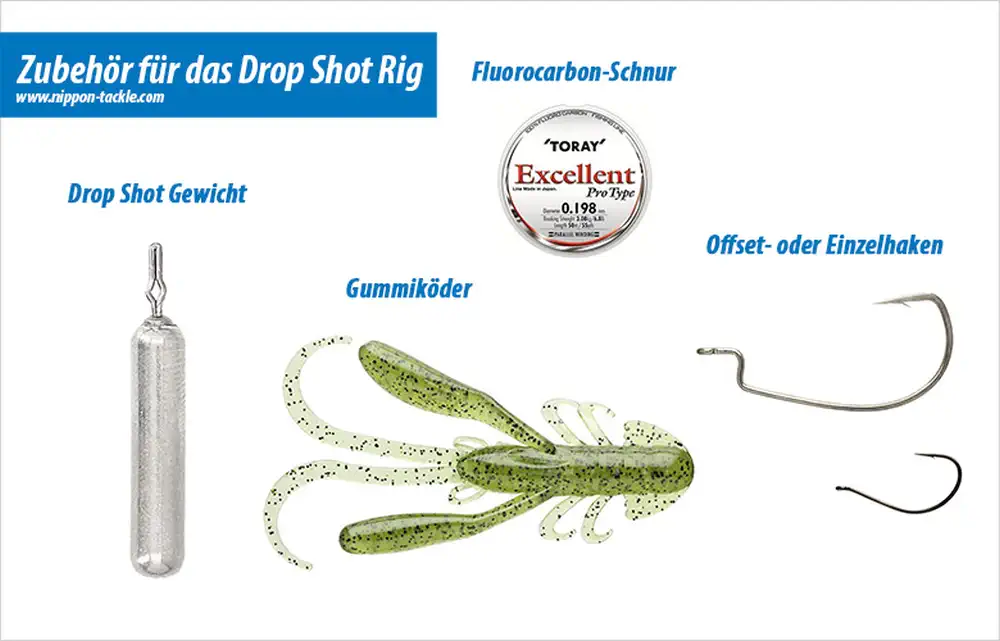Drop Shot Rig - Assembly & instruction
Das Dropshot-Rig ist das vielleicht bekannteste Finesse-Rig in Deutschland. Bevor andere Exoten wie z.B. das Neko-Rig hier bekannt wurden, gab es das DS-Rig schon sehr lange. Eigentlich in den USA zum Vertikalangeln auf Schwarzbarsch entwickelt, erfreute es sich hier auch sofort an Beliebtheit bei Uferanglern. Nur die wenigsten haben die Möglichkeit von einem Boot einen Hot-Spot punktuell und intensiv aus zu fischen. Doch das Drop-Shot-Rig gibt auch den anderen die Möglichkeit dazu.
Im Gegensatz zum klassischen Jigkopf ist der Köder beim Dropshot-Rig vom Gewicht getrennt. Dadurch könnt ihr das Gewicht je nach Strömung, Tiefe oder Aktivität der Fische verändern, ohne dass es eine Auswirkung auf das Laufverhalten des Köders hat. Zusätzlich steht der Köder dauerhaft - sofern ihr genug Spannung auf der Schnur haltet - über dem Grund. So ist es perfekt im Sichtfeld der lauernden Räuber. Die Strömung unter Wasser animiert dauerhaft euren Softbait, so dass ihr selbst ohne aktive Bewegung über die Rute einen fängigen Köder unter Wasser präsentiert. Selbst im Stillgewässer gibt es Strömungen. Dadurch ist das Drop-Shot-Rig nicht nur für Fliessgewässer interessant.
The setup: Required material and suitable knots
Tying a dropshot rig is not difficult. You need a monofilament main line (often FC), a suitable single hook and a drop-shot weight. The single hook is tied to the leader using a Palomar knot. This requires some practice at the beginning, but is relatively easy to do. This knot ensures that the hook always sticks out at a 90° angle from the leader. This way, the bait is naturally presented horizontally in the water. Leave approx. 30-50 cm of space between the hook and the weight. You need this distance so that the lure has sufficient distance from the bottom of the water despite the acute angle from the bank. Of course, you should always be flexible and try out different lengths. But remember: the further away you fish, the more acute the angle becomes. You should therefore choose a greater distance.
There are special weights for dropshot fishing, which usually have a clamping eye. The end of the leader is pulled through this. The line now sits firmly in this narrow point. This has several direct advantages: you can replace the weight in seconds. The current can change quickly, especially on large industrial rivers. It is not uncommon for the DS weight to get caught in stones or obstacles due to its mobility. If it gets stuck, in most cases the line will come loose from the clip and you will only have lost the weight.
If you knot the single hook directly onto the leader, you have a disadvantage: your lure will only point in one direction as it is firmly attached to the line. Our special DS hooks provide a remedy here. The single hooks are attached to a barrel swivel. This allows them to rotate freely around the axis of the leader. In addition to the improved bite yield, this also makes the lure more attractive as it can move more.
The drop-shot rig is suitable for all our native predators. It is only important that you adjust the bait and hook size accordingly. The classics are of course perch and zander. But chub and trout also like the presentation. If you want to fish for pike with the DS rig, remember to use a pike-proof leader!
Just a typical winter rig? Lure guidance in running behavior in detail
The dropshot rig was specially developed for a slow and precise presentation. You should therefore adapt your bait presentation accordingly. It is not necessarily a rig for searching a large area for fish. It is better suited for hot spots where you suspect fish.
With the rod held high, you keep a certain basic tension on the line. With short jumps or light tugs, you can let your lure dance on the spot and fish out the hot spot bit by bit.
It is important to incorporate lots of pauses. Because even without active animation, the lure plays under water and is always in the predator's field of vision due to the separation of weight and hook.
As you probably already know, our predators don't like the same lure presentation every day and in every situation. Therefore, try out different lures relatively early on to see which one gets the most attacks. Once you have found this out, you can annoy them at the spot until they decide to bite.
The slow presentation makes the dropshot rig particularly suitable for cold days or situations in which the predators are inactive. However, you can also lead the rig with a little speed so that active fish are also attracted.
